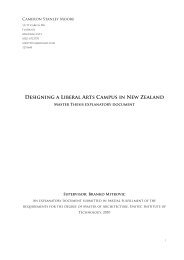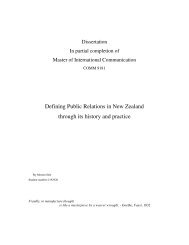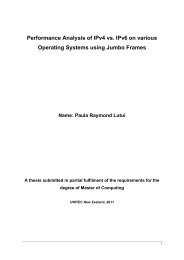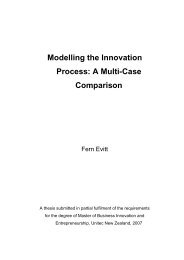The Study of Students Perceptions of On-campus ... - Research Bank
The Study of Students Perceptions of On-campus ... - Research Bank
The Study of Students Perceptions of On-campus ... - Research Bank
You also want an ePaper? Increase the reach of your titles
YUMPU automatically turns print PDFs into web optimized ePapers that Google loves.
view, pr<strong>of</strong>essors could use these features to help improve their teaching.<br />
From the students’ point <strong>of</strong> view, they could benefit from instant feedback<br />
and communicate during the class. With the eight features, the classrooms<br />
would become more flexible and functional. <strong>The</strong> rules for exams may need<br />
to be changed in that they are not only “open book” but also “open web”.<br />
Roshan & Leary (2003) mentioned several considerations for design <strong>of</strong><br />
wireless LAN in an educational environment. <strong>The</strong> first consideration was<br />
the convenience: “WLANs give them the opportunity to provide ubiquitous<br />
coverage so that they can bring networks to the students instead <strong>of</strong> bringing<br />
the student to the network” (Roshan & Leary, 2003, pp. 246-247). <strong>The</strong><br />
second consideration was the cost savings: “As computers have become a<br />
larger part <strong>of</strong> the learning process, the time and resource savings that<br />
wireless brings has proven to be rewarding” (Roshan & Leary, 2003, pp.<br />
246-247). <strong>The</strong> third consideration was no physical boundaries: “many<br />
school buildings were designed before the computer revolution. It just might<br />
not be feasible to run wires to the students” (Roshan & Leary, 2003, pp.<br />
246-247). <strong>The</strong> fourth consideration was the challenges, in deploying<br />
wireless in an educational environment, <strong>of</strong> “ensuring that the<br />
infrastructure can support a multivendor client environment” (Roshan &<br />
Leary, 2003, pp. 246-247). This means “these scenarios create a situation<br />
that can include client devices with many different operating systems and<br />
with wireless NIC devices that need to communicate with a common<br />
infrastructure” (Roshan & Leary, 2003, pp. 246-247). <strong>The</strong> fifth<br />
consideration was security. <strong>The</strong> wireless LAN provider might want to<br />
restrict the access level for different user groups. Roshan & Leary (2003)<br />
believed that “the easiest and most rapidly deployable solution might be to<br />
employ wireless bridges to connect the remote network with the school<br />
network.”<br />
8











